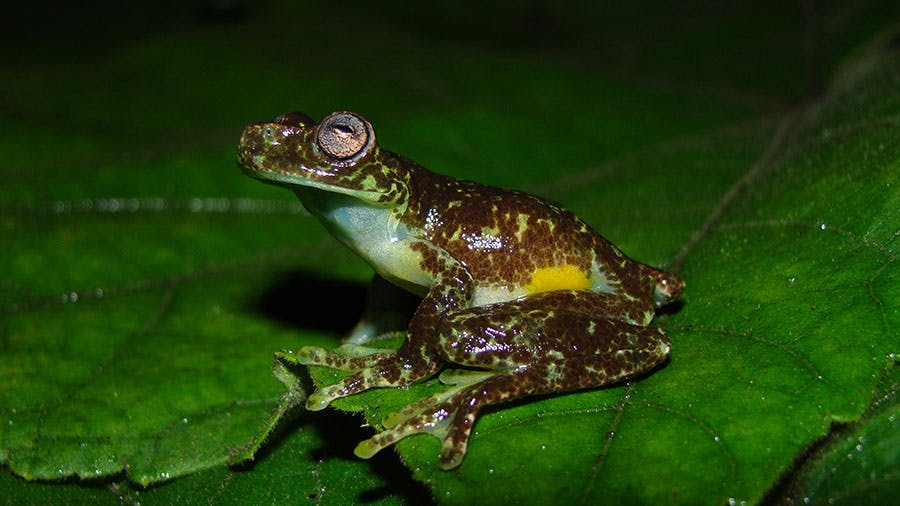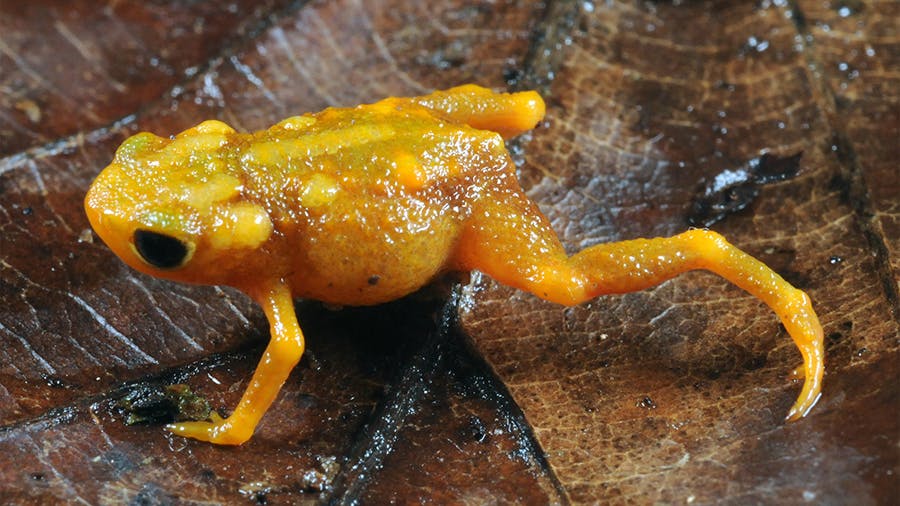 BACK TO NEWS
BACK TO NEWSOn the mountain of the Golden Toad
The search for a lost species continues in Costa Rica’s ethereal cloud forests
By Trevor Ritland on January 20, 2022 
In the early evening, the old trees cast long shadows and the last light glimmered in the water of the secret pools high in the cloud forest. Ahead of us, the hidden path wound upward into the dark, and the first songs of the emerging frogs called us deeper into the jungle. It was June of 2021, and we were searching for the Golden Toad—a lost species, possibly now only a legend—in the Children’s Eternal Rainforest of the Tilarán mountains near Monteverde, Costa Rica. The odds were against us and the trail was long, and we had many miles left to go before we reached the ridge, where the very last of the iconic species had been seen thirty years ago.
The rediscovery of a lost species, when it does happen, doesn’t happen overnight. It requires local knowledge of unique habitats and an understanding of the behavior of some of the world’s most secretive species; it often requires international resources, and always time and intention. It also requires courage; it is easy to look into the clouds at a distant mountaintop and wonder “what if…?”—it is more difficult to risk muddying the hope with a sometimes disappointing reality: to climb the mountain and not find what you are looking for.
A mysterious history
For 25 years following its scientific description in 1965, the golden toad (Incilius periglenes) fascinated biologists and local residents alike, emerging from hidden hollows in the high cloud forest of Monteverde at the onset of the year’s first rains to gather in the thousands at ephemeral breeding pools, then disappear again beneath the earth. Their catastrophic decline and ultimate disappearance in the late 1980s heralded the beginning of a global amphibian crisis, to which climate change and a pandemic called chytrid fungus have been ascribed the blame. Found nowhere else in the world except the cloud forests of Monteverde’s Tilarán mountains, the Golden Toad has become a symbol of modern-day extinction—but it may not be too late for it to become a symbol of hope.
Though sightings in 1988 and 1989 by visiting biologists Martha Crump and Frank Hensley are often cited as the last observations of the golden toads, a local naturalist named Eladio Cruz — who grew up farming with his father in the San Luis valley on the mountain’s Pacific slope — speaks of a later sighting in 1991, two years after the species was believed to have disappeared for good. While assisting with fieldwork in a remote area of the Children’s Eternal Rainforest, Eladio says, he encountered a large group of males, females, and tadpoles, which had somehow escaped or endured the calamity that had decimated their kin. Listening to his story is like crossing paths with a ghost.
Protecting a rainforest
The Children’s Eternal Rainforest began with the founding of the Monteverde Conservation League in 1986, when a group of local conservationists, Quaker naturalists, and expatriate biologists came together with the mission of purchasing land around Monteverde to preserve the remaining forest and allow cleared areas to regenerate. The following year, Sharon Kinsman—a US biologist who was doing field work in Monteverde—traveled to Sweden to give a slideshow presentation to local schoolchildren. When the students learned that they could purchase Monteverde forest for conservation a few hectares at a time, their fundraising efforts soon inspired other schoolchildren in more than 40 countries. In a snowball effect, larger donors became involved, and the Monteverde Conservation League found itself in a position to make meaningful land purchases.
“And most of what today is the 23,000-hectare reserve was purchased in the first few years after that,” says Mark Wainwright, a board member of the Monteverde Conservation League. “Two hundred-twenty different properties became the largest private reserve in Costa Rica. And as a tribute to the Swedish school kids, they gave it the name the Children’s Eternal Rainforest.”
When serious discussions began around returning to the location of Eladio’s last sighting, Mark Wainwright agreed to accompany the expedition as a representative from the Monteverde Conservation League. Gilbert Alvarado, a biologist from the University of Costa Rica who has been integral in the rediscovery of other vanished frogs in Costa Rica, joined us as well. With support from Re:wild, my brother Kyle and I traveled with the team to document the search for the lost Golden Toad. Luis Solano—the former maintenance coordinator for the Children’s Eternal Rainforest—led the way with Eladio Cruz. It was Eladio’s first time back to the site after more than 30 years.
Into the cloud forest
As we hiked up into the elfin forest, following a path Luis cut out with his old machete, it was difficult not to ruminate on the uncertainty of the objective. If we did find the Golden Toad escaping extinction high in the secret pools of the hidden mountain, it would be only the beginning.
Speaking about other rediscoveries in Costa Rica, Gilbert notes that “just because we find these populations doesn’t mean that everything is okay. We have a population that is very vulnerable with a lot of threats. It means we need to do more work to help these small populations that we have found. If we do anything wrong, that population is going to disappear again. They may have come back, but they are still at the edge of extinction. On the one hand, there is hope; on the other, a great responsibility.”
But local history brings some solace. When Mark Wainwright rediscovered Monteverde’s Green-eyed Frog (Lithobates vibicarius) in the early 2000s—a once-common species that had disappeared in the late 1980s—successful local and international partnerships helped the species to rebound through breeding projects and environmental education programs, and today there are populations living in the Children’s Eternal Rainforest and beyond. Without that support, it is unknown if the species would have been able to climb back from the edge of extinction.
Late in the evening, we emerged onto the ridge-line where, 30 years ago, Eladio had beheld the remnant population of Golden Toads. The group split up to explore the shallow rain pools that had collected in root hollows from the recent storms — the habitat in which the Golden Toads had appeared before their decline. Luis discovered a number of rare and notable frogs—Isthmohyla angustilineata, Lithobates vibicarius, Lithobates warszewitschii—all indicating a slow repatriation of elevations once abandoned by these species, but we encountered no Golden Toads on the slopes of the hidden mountain.
As we sat on that ridge-line and darkness settled over the mountain, I asked Eladio if he would continue searching for the Golden Toad, when we had not found them at this fabled site and the world was not getting any bigger.
“Possibly,” he whispered, sounding tired but still hopeful. “This is the idea—to keep looking.”
I have no doubt that Eladio will keep looking, and if I hear word one day that he has found the toads again along the dark and unknown trails of the eternal forest, the news will not surprise me. After all, there are many valleys and ridge-lines in the Children’s Eternal Rainforest that have not been explored.
“There are incredible places out there, but we haven’t reached them,” Luis Solano says. “There are a lot of mountains, a lot of streams that you see from afar, and you wish you could go — but maybe that is not the point of the expedition, or you don’t have time — so they remain unseen.”
In the dark, we descended down the hidden trail in the dim light of our headlamps, and a slow mist swept over a lively forest, the calls of frogs fading behind us as we left the ridge. We would return to this and other sites in the following days, but we would find no golden toads among the twisted roots and secret waters: if they were there, then we were not destined to encounter them. At the foot of the mountain, we piled into the truck and drove in silence back to our base camp, collapsing into dreams of golden toads dancing in the enchanted forest.
Absence does not always mean extinction. They may be out there, and they may not—I believe that these are not mutually exclusive possibilities, just as hope and grief are not contradictory emotions; we can mourn for the Golden Toad, and we can wish for its return; we can prepare a place for it, even if it never comes back. We can make our peace with the ghost; we are all the Golden Toad now.
Today, the Children’s Eternal Rainforest is protected, but as we sat with Mark Wainwright at the Cafe Monteverde in the days following our return — his new son sleeping in his lap — Mark reminded me that purchasing the land is only the beginning of conservation.
“You can’t just fence it off,” he said.
Local collaboration, along with international support, will be necessary in sustaining one of the last great forests of Central America. To honor the Golden Toad, we must protect and restore the places that it once called home — working to make these forests truly eternal.
When I find myself in Monteverde again, I will hold out hope for a flash of gold among the tangled roots in the dark forest, and in the shadow of the mountain, the story will continue. Gilbert has plans to return to the far-away site to swab the re-emerging frogs and test for the presence of the chytrid fungus. If the fungus is detected but the populations are persisting, they may hold clues to a resilience against the pathogen. As Gilbert noted on our long walk down the mountain: “Maybe the survivors will tell a different story.”
Stay tuned for Adventure Term's upcoming documentary film exploring the ongoing search for the Golden Toad.
About the author
Trevor Ritland
After two years in the cloud forest, Trevor Ritland returned to the United States to form Adventure Term, a nonprofit initiative training the next generation of creative environmental storytellers. Stay tuned for Adventure Term's upcoming documentary film exploring the ongoing search for the Golden Toad. You can read more about Trevor’s search in Orion magazine, or watch the full-length documentary from Adventure Term here: www.adventureterm.com/the-search-for-the-golden-toad.


